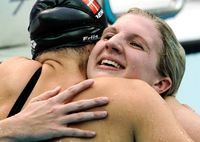
Crosscultural studies dating back to 1911 have shown that people tend to operate in 3-second bursts. Goodbye waves, musical phrases, and infants' bouts of babbling and gesturing all last about 3 seconds. Many basic physiological events, such as relaxed breathing and certain nervous system functions do, too. And several other species of mammals and birds follow the general rule in their body-movement patterns. A 1994 study of giraffes, okapis, roe deer, raccoons, pandas, and kangaroos living in zoos, for example, found that although the duration of the animals' every move, from chewing to defecating, varied considerably, the average was, you guessed it, 3 seconds.
"What we have is very broad research showing that we experience the world in about these 3-second time frames," says developmental psychologist Emese Nagy of the University of Dundee in the United Kingdom.
Hugs also appear to fit the pattern. In 2008, Nagy, a gymnastics fan, was watching the Beijing Summer Olympics on television and noticed a lot of hugging going on. Most of the previous 3-second research had been done on individuals, and she wondered whether the pattern would hold for an experience shared between two people, especially one as intimate and emotionally charged as an embrace.
So Nagy conducted a frame-by-frame analysis of video recordings of the Olympic finals in 21 sports, among them badminton, wrestling, and swimming. She had an independent observer time 188 hugs between athletes from 32 nations and their coaches, teammates, and rivals.
Regardless of the athletes' and their partners' gender or national origin, the hugs lasted about 3 seconds on average, Nagy reports this month in the Journal of Ethology. Not surprisingly, the identity of the partner mattered: athletes hugged their coaches somewhat longer than they did their teammates and hugged their opponents the shortest amount of time.
The results reinforce an idea current among some psychologists that intervals of about 3 seconds are basic temporal units of life that define our perception of the present moment. Put another way, what one psychologist called the "feeling of nowness" tends to last 3 seconds.
That rhythm has fundamentally shaped humans' biological and social evolution, says neuroethologist Geoffrey Gerstner of the University of Michigan, Ann Arbor, who co-authored the 1994 paper on zoo animals. If it were instead much faster, say 10 milliseconds, then we could react much more quickly to incoming stimuli, such as potential threats. "Bullets would be as frightening to us as somebody throwing a ball at us," Gerstner says, "whereas if we lived in 1-minute-duration periods, there's an awful lot of things that could happen in the natural world that we just wouldn't be able to respond to." Either way, there would be big consequences for our survival.
Colwyn Trevarthen, a psychobiologist at the University of Edinburgh in the United Kingdom, agrees that the 3-second pattern is of paramount importance as the foundation of our conscious experience. But he points out that the body has other rhythms, too, including split-second reflexes. All of them make up our natural sense of time, which is hardly a rigid metronome. "We're not talking about something crude and automatic. We're talking about something flexible and highly expressive," Trevarthen says. "It's biological. It's mental. It's spiritual. This is the timing of the human spirit."



The 3-second pattern is of paramount importance as the foundation of our conscious experience. "We're not talking about something crude and automatic. We're talking about something flexible and highly expressive, "It's biological. It's mental. It's spiritual. This is the timing of the human spirit."